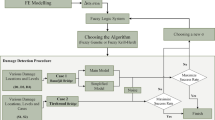Abstract
A methodology for performance evaluation of reinforced concrete bridge girders in corrosive environments is proposed. The methodology uses the concept of performability and considers both serviceability - and ultimate - limit states. A non-homogeneous Markov chain is used for modelling the condition state evolution of the bridge girder with time. The condition states of the bridge girder are represented by fuzzy sets to consider the ambiguities arising due to the linguistic classification of condition states. The methodology is illustrated through the performance evaluation of a reinforced concrete T-beam bridge girder.
Access this chapter
Tax calculation will be finalised at checkout
Purchases are for personal use only
Similar content being viewed by others
References
AASHTO (2003) Manual for condition evaluation and load and resistance factor rating (LRFR) of highway bridges. American Association of State Highway Officials, Washington, DC
Aktan AE, Farhey DN, Brown DL, Dalal V, Helmicki AJ, Hunt V, Shelley SJ (1996) Condition assessment for bridge management. J Infrastruct Sys ASCE 2(3):108–117
Anoop MB (2009) Remaining life assessment of reinforced concrete structural elements subjected to chloride-induced corrosion of reinforcement. PhD thesis, Department of Civil Engineering, Indian Institute of Science, Bangalore
Anoop MB, Balaji Rao K, Lakshmanan N (2008) Safety assessment of austenitic steel nuclear power plant pipelines against stress corrosion cracking in the presence of hybrid uncertainties. Int J Press Vessels Pip 85(4):238–247
Balaji Rao K, Anoop MB, Lakshmanan N (2004a) Modelling the evolutionary non-guassian processes using NHGMC. In: Proceedings of the International Congress on Computational Mechanics and Simulation (ICCMS-2004), Indian Institute of Technology, Kanpur, India, 9–12 Dec 2004, vol I, pp 182–189
Balaji Rao K, Anoop MB, Lakshmanan N, Gopalakrishnan S, Appa Rao TVSR (2004) Risk-based remaining life assessment of corrosion affected reinforced concrete structural members. J Struct Eng 31(1):51–64
Bhattacharyya M (1998) Fuzzy Markovian decision process. Fuzzy Sets Syst 99:273–282
BIS (2000) Indian standard code of practice for plain and reinforced concrete: IS 456-2000. Bureau of Indian Standards, New Delhi
Bolch G, Greiner S, de Meer H, Trivedi KS (1998) Queuing networks and Markov chains: modeling and performance evaluation with computer science applications. Wiley, New York
Cesare MA, Santamarina C, Turkstra C, Vanmarcke EH (1992) Modeling bridge deterioration with Markov chains. J Transp Eng ASCE 118(6):820–833
Chase SB, Gáspár L (2000) Modeling the reduction in load capacity of highway bridges with age. J Bridge Eng ASCE 5(4):331–336
Corotis RB (2009) Risk communication with generalized uncertainty and linguistics. Struct Saf 31:113–117
Crank J (1975) Mathematics of diffusion. Oxford University Press, Oxford
Durango-Cohen PL, Madanat SM (2008) Optimization of inspection and maintenance decisions for infrastructure facilities under performance model uncertainty: a quasi-Bayes approach. Transp Res Part A 42:1074–1085
fib (2006) Model code for service life design. fib Bulletin 34. International Federation for Structural Concrete, Lausanne
Frangopol DM, Kallen M-J, van Noortwijk JM (2004) Probabilistic models for life-cycle performance of deteriorating structures: review and future directions. Prog Struct Eng Mater 6(4):197–212
Godart B, Vassie PR (2001) Bridge management systems: extended review of existing systems and outline framework for a European system. BRIME Deliv D13:PL97–PL2220
Jiang M, Corotis RB, Ellis JH (2000) Optimal life-cycle costing with partial observability. J Infrastruct Syst ASCE 6(2):56–66
Lay S, Schießl P (2003) LIFECON deliverable 3.2: service life models. cbm-Technische Universität München
Minervino C, Svakumar B, Moses F, Mertz D, Edberg W (2004) New AASHTO guide manual for load and resistance factor rating of highway bridges. J Bridge Eng ASCE 9(1):43–454
NYDoT (1997) Bridge inspection manual. New York State Department of Transportation, New York
Platis A (2006) A generalized formulation for the performability indicator. Comput Math Appl 51:239–246
Platis A, Limnios N, Du ML (1998) Dependability analysis of systems modeled by non-homogeneous Markov chains. Reliab Eng Syst Saf 61:235–249
Raupach M, Warkus J, Gulikers J (2006) Damage process due to corrosion of reinforcement bars – current and future activities. Mater Corros 57(8):648–653
Rodriguez J, Ortega LM, Casal J, Diez JM (1996) Assessing structural conditions of concrete structures with corroded reinforcement. In: Dhir RK, Jones MR (eds) Concrete repair, rehabilitation and protection. E&FN Spon, London, pp 65–78
Ryan TW, Hartle RA, MannJE, Danovich LJ (2006) Bridge inspector’s reference manual. Report No. FHWA NHI 03-001. Federal Highway Administration National Highway Institute, Virginia
Sanders WH, Meyer JF (1991) A unified approach for specifying measures of performance, dependability ad performability. In: Avizicuis A, Lapric J (eds) Dependable computing for critical applications. Springer, New York, pp 515–537
Smith RM, Trivedi KS, Ramesh AV (1988) Performability analysis: measures, an algorithm and a case study. IEEE Trans Comput 37(4):406–417
Symeonaki MA, Stamou GB (2004) Theory of Markov systems with fuzzy states. Fuzzy Sets Syst 143(3):427–445
Vidal T, Castel A, Francois R (2004) Analyzing crack width to predict corrosion in reinforced concrete. Cement Concr Res 34(1):165–174
Vu KAT, Stewart MG (2005) Predicting the likelihood and extent of reinforced concrete corrosion-induced cracking. J Struct Eng ASCE 131(11):1681–1689
Acknowledgements
This chapter is being published with the kind permission of the Director, CSIR-SERC, Chennai.
Author information
Authors and Affiliations
Corresponding author
Editor information
Editors and Affiliations
Rights and permissions
Copyright information
© 2013 Springer India
About this paper
Cite this paper
Anoop, M.B., Rao, K.B. (2013). Performability Analysis of Reinforced Concrete Bridge Girders in Corrosive Environments Using Markov Chains with Fuzzy States. In: Chakraborty, S., Bhattacharya, G. (eds) Proceedings of the International Symposium on Engineering under Uncertainty: Safety Assessment and Management (ISEUSAM - 2012). Springer, India. https://doi.org/10.1007/978-81-322-0757-3_81
Download citation
DOI: https://doi.org/10.1007/978-81-322-0757-3_81
Published:
Publisher Name: Springer, India
Print ISBN: 978-81-322-0756-6
Online ISBN: 978-81-322-0757-3
eBook Packages: EngineeringEngineering (R0)




